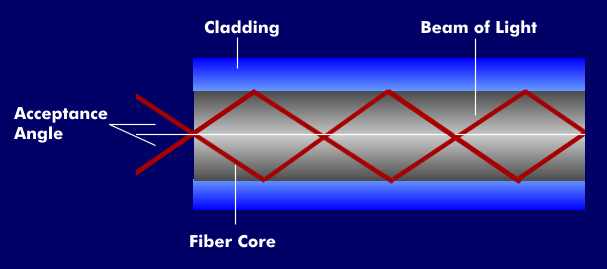acceptance angle
The term acceptance angle occurs in optoelectronics and acoustics. It is the maximum angle of incidence at which light or sound from an external radiation source or medium can be picked up by a light sensor or microphone. This angle of incidence is called the acceptance angle.
- In light wave transmission, the acceptance angle is decisive for the light wave reflection at the boundary layer between core glass and cladding glass in the optical waveguide. The acceptance angle is the angle of incidence at which light can be fed into the core glass and guided there. Acceptance If a light beam enters an optical waveguide with an angle of incidence that is too large, total reflection no longer occurs at the boundary layer between the core glass and cladding glass, which means that light beams enter the cladding glass and are thus lost for transmission. Such an angle of incidence is called the critical angle. Typical values for a step fiber are 17.5°, for a gradient fiber 11.5 % and for a monomode fiber 2.5 %. The sine of the acceptance angle is the numerical aperture.
- In acoustics, the term acceptance angle is used for microphones. It refers to the frontal angle at which the sensitivity of the perpendicularly incident sound does not fall below -3 dB of the maximum value. For example, omnidirectional microphones have equal sensitivity values in all directions. This means that their acceptance angle is +/-180°. For microphones with a cardioid polar pattern, the acceptance angles range from 130° for the classic cardioid shape, 115° for the supercardioid shape and 105° for the hypercardioid shape, depending on the cardioid characteristic.

